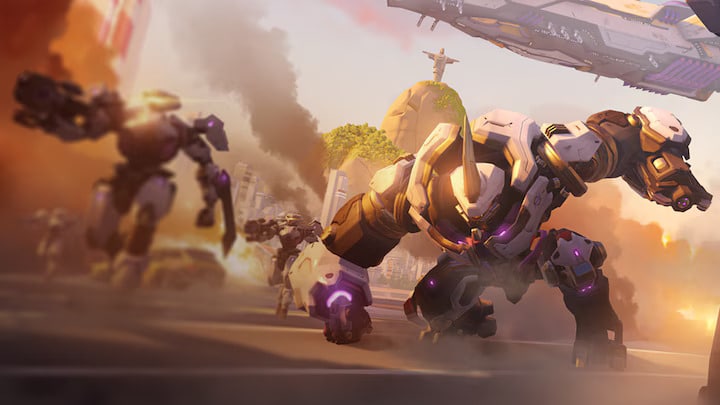In the often tumultuous world of game development, few journeys are as publicly scrutinized as that of Overwatch 2. What began as the highly anticipated continuation of a beloved hero shooter quickly found itself navigating a complex landscape of shifting visions, player expectations, and undeniable growing pains. Recently, lead figures — Director Aaron Keller, Art Director Dion Rogers, and Associate Game Director Alec Dawson — offered a remarkably candid reflection on the past three years, not just acknowledging the struggles, but outlining a determined path to reignite the game`s once-fabled “magic.”

A visual representation of Overwatch 2`s dynamic battlefield scenarios, emblematic of its evolving gameplay focus.
The Fading Aura: When “Magic” Evaporated
Aaron Keller’s poignant observation that the original Overwatch “felt like magic” upon its inception, a synergy that “evaporated” during the sequel`s production, cuts to the heart of Overwatch 2`s early challenges. The initial vision for the game was ambitious, aiming to weave a deep, narrative-driven PvE experience that would expand the universe`s rich lore. However, as Keller recounts, this grand design proved difficult to execute, leading to a profound “realign[ment] and redefine[ment]” of what Overwatch 2 was destined to be.
This period of introspection was not without its public cost. Players, many of whom were drawn in by the promise of extensive story missions, felt a degree of betrayal when these PvE elements were significantly scaled back. It was a classic tale of a sequel struggling to find its identity, caught between the legacy of its predecessor and an evolving, often unforgiving, market.
The Pivot: Reclaiming the PvP Arena
The turning point, according to the developers, came with a renewed, uncompromising focus on the game`s competitive PvP core. Associate Game Director Alec Dawson, who joined the team in 2022, described a period of structural re-evaluation, asking how they could deliver “more impactful seasons and surprise players.” This wasn`t merely a reactive patch-up job; it was a strategic pivot to embrace what Overwatch has always excelled at: tight, tactical hero-based combat.
Dawson`s innovative “Perks” concept, pitched after Season 9 and eventually implemented in Season 15, serves as a prime example of this new philosophy. Despite initial implementation challenges, these hero-altering abilities were a deliberate risk aimed at empowering players to customize their gameplay experience. The positive reception, coupled with other improvements like “Stadium” in Season 16, signaled a critical shift. Keller notes, “Our community noticed the changes and improvements we were making, so we gradually started making those bigger and bolder.” The “magic,” it seemed, was starting to trickle back, leading the team to optimistically declare Overwatch 2 as “so back.”
Lessons Learned and Future Frontiers
The developer`s journey through this challenging period yielded crucial insights. The primary takeaway? The necessity to “surprise and delight” players, rather than merely reacting to feedback. This ethos represents a shift towards proactive innovation and a greater willingness to “take risks and… give ourselves tougher challenges.”
Looking ahead, Art Director Dion Rogers teased exciting developments:
- A new, as-yet-unannounced hero.
- “Bold new directions” in the game`s visual and thematic presentation.
- Exploration of “untapped corners of the Overwatch universe.”
- Experimentation with fresh storytelling styles.
While these promises offer a tantalizing glimpse into Overwatch 2`s future, they also arrive with a familiar undercurrent of community skepticism. The memory of past unfulfilled promises lingers, creating a challenge for Blizzard: not just to deliver, but to consistently rebuild trust through tangible, player-centric innovation.
Impact on the Competitive Landscape: Overwatch 2 Esports
The intensified focus on PvP naturally has profound implications for the Overwatch 2 esports scene. Changes to core gameplay, such as the introduction of Perks in the Overwatch Champions Series (OCS) in February 2025, directly influence team compositions, strategies, and the overall competitive meta. This constant evolution ensures the esports landscape remains dynamic and engaging for both players and viewers.
If the developers continue to deliver impactful and well-received gameplay innovations, it stands to reason that viewership for competitive Overwatch 2 could see significant growth. The synergy between a thriving casual player base and a vibrant esports scene is crucial for long-term success, and Blizzard appears keen on nurturing both.
Conclusion: A Path Forward, Paved with Risks
Overwatch 2`s narrative is far from over. From the initial struggle to define its purpose, through a critical pivot back to its competitive roots, and now towards an era of ambitious new content, the game represents a fascinating case study in modern live-service development. The developers` candid admission of past missteps, combined with a newfound resolve to embrace risk and innovation, paints a picture of a team determined to earn back the community`s adoration.
The return of the “magic” remains an ongoing quest. Yet, with a clearer vision and a commitment to surprising players with meaningful updates, Overwatch 2 is charting a course that, while challenging, appears genuinely revitalized. The stage is set for a future where players might just rediscover the spark that made them fall in love with the Overwatch universe in the first place.
